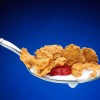Experiment: Remove Iron from Cereal
You may have heard tales of the additives in processed foods, but have you ever actually seen them? Unlike fairy tales, food additives do exist and can be found in many common processed foods.
Like the characters in fairy tales, there seem to be good and bad additives. Some would agree that sugar or sweeteners like high fructose corn syrup are bad, although the denotation of bad additives is a somewhat controversial topic in the health world. Most additives that do get a bad reputation seem to do so from high quantity consumption and not from the nature of the substance itself. However, few would argue that iron is not a good additive.
Iron is added to many processed foods for mineral enrichment and can be extracted with a simple experiment using strong magnets. Iron removal is a great classroom or at home experiment that adults can do with kids. With this simple experiment that we have outlined below you can pull out the added iron in breakfast cereals and examine the additive with the naked eye.
Supplies
- Iron-containing breakfast cereal
- Strong magnet
- Measuring cups
- Resealable plastic bag
- Large mixing bowl
- Potato masher
Steps
- You’ll need approximately 1 to 1 ¼ cup of cereal. Pour the cereal into a mixing bowl.
- Use a potato masher to crush the cereal into a powder form.
- Once the cereal is crushed to a fine powder, hold the strong magnet right above the cereal no more than a ¼ inch away.
- Observe whether or not iron has attached to the magnet. If not, crush the cereal finer or move the magnet closer. Eventually, the magnet should extract iron.
- Now that you’ve tried extracting iron from dry cereal pour the crushed cereal from a bowl to a resealable plastic bag.
- Pour in warm water until the bag is about half water and half cereal.
- Seal the bag and mix the cereal and water until it is evenly dispersed.
- Grab your strong magnet again and hold it inside the resealable bag. Alternatively, you can flatten the bag while it is still sealed and press the magnet against the cereal. With either method a clump of iron should attract to the magnet.
Take It A Step Further
For added fun, you can use 3 different types of cereal with increasing iron content:- 25% or less iron content
- 25-50% iron content
- 75% iron content
Save the nutrition labels from the cereal boxes and have students check their hypotheses after they have completed the experiment. Be sure to clean up and dispose of the iron particles in a safe manner.
Experiment More With Apex Magnets
If you're interested in more science experiments with magnets, be sure to follow the magnet experiments section of our blog. You can also view magnet safety tips, or contact us with any questions.

